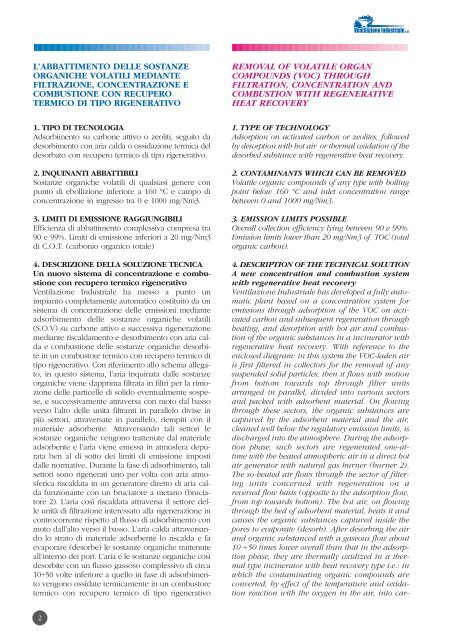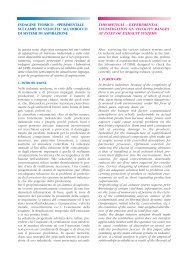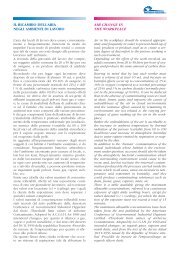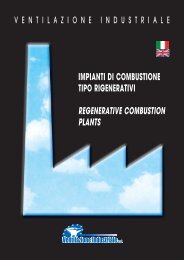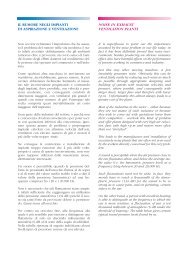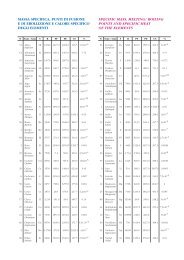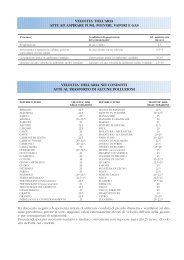l'abbattimento delle sostanze - Ventilazione Industriale
l'abbattimento delle sostanze - Ventilazione Industriale
l'abbattimento delle sostanze - Ventilazione Industriale
- No tags were found...
Create successful ePaper yourself
Turn your PDF publications into a flip-book with our unique Google optimized e-Paper software.
L’ABBATTIMENTO DELLE SOSTANZEORGANICHE VOLATILI MEDIANTEFILTRAZIONE, CONCENTRAZIONE ECOMBUSTIONE CON RECUPEROTERMICO DI TIPO RIGENERATIVOREMOVAL OF VOLATILE ORGANCOMPOUNDS (VOC) THROUGHFILTRATION, CONCENTRATION ANDCOMBUSTION WITH REGENERATIVEHEAT RECOVERY1. TIPO DI TECNOLOGIAAdsorbimento su carbone attivo o zeoliti, seguito dadesorbimento con aria calda o ossidazione termica deldesorbato con recupero termico di tipo rigenerativo.2. INQUINANTI ABBATTIBILISostanze organiche volatili di qualsiasi genere conpunto di ebollizione inferiore a 160 °C e campo diconcentrazione in ingresso tra 0 e 1000 mg/Nm3.3. LIMITI DI EMISSIONE RAGGIUNGIBILIEfficienza di abbattimento complessiva compresa tra90 e 99%. Limiti di emissione inferiori a 20 mg/Nm3di C.O.T. (carbonio organico totale)4. DESCRIZIONE DELLA SOLUZIONE TECNICAUn nuovo sistema di concentrazione e combustionecon recupero termico rigenerativo<strong>Ventilazione</strong> <strong>Industriale</strong> ha messo a punto unimpianto completamente automatico costituito da unsistema di concentrazione <strong>delle</strong> emissioni medianteadsorbimento <strong>delle</strong> <strong>sostanze</strong> organiche volatili(S.O.V) su carbone attivo e successiva rigenerazionemediante riscaldamento e desorbimento con aria caldae combustione <strong>delle</strong> <strong>sostanze</strong> organiche desorbitein un combustore termico con recupero termico ditipo rigenerativo. Con riferimento allo schema allegato,in questo sistema, l’aria inquinata dalle <strong>sostanze</strong>organiche viene dapprima filtrata in filtri per la rimozione<strong>delle</strong> particelle di solido eventualmente sospese,e successivamente attraversa con moto dal bassoverso l’alto <strong>delle</strong> unità filtranti in parallelo divise inpiù settori, attraversate in parallelo, riempiti con ilmateriale adsorbente. Attraversando tali settori le<strong>sostanze</strong> organiche vengono trattenute dal materialeadsorbente e l’aria viene emessa in atmosfera depurataben al di sotto dei limiti di emissione impostidalle normative. Durante la fase di adsorbimento, talisettori sono rigenerati uno per volta con aria atmosfericariscaldata in un generatore diretto di aria caldafunzionante con un bruciatore a metano (bruciatore2). L’aria così riscaldata attraversa il settore <strong>delle</strong>unità di filtrazione interessato alla rigenerazione incontrocorrente rispetto al flusso di adsorbimento conmoto dall’alto verso il basso. L’aria calda attraversandolo strato di materiale adsorbente lo riscalda e faevaporare (desorbe) le <strong>sostanze</strong> organiche trattenuteall’interno dei pori. L’aria e le <strong>sostanze</strong> organiche cosìdesorbite con un flusso gassoso complessivo di circa10÷50 volte inferiore a quello in fase di adsorbimentovengono ossidate termicamente in un combustoretermico con recupero termico di tipo rigenerativo1. TYPE OF TECHNOLOGYAdsorption on activated carbon or zeolites, followedby desorption with hot air or thermal oxidation of thedesorbed substance with regenerative heat recovery.2. CONTAMINANTS WHICH CAN BE REMOVEDVolatile organic compounds of any type with boilingpoint below 160 °C and inlet concentration rangebetween 0 and 1000 mg/Nm3.3. EMISSION LIMITS POSSIBLEOverall collection efficiency lying between 90 e 99%.Emission limits lower than 20 mg/Nm3 of TOC (totalorganic carbon).4. DESCRIPTION OF THE TECHNICAL SOLUTIONA new concentration and combustion systemwith regenerative heat recovery<strong>Ventilazione</strong> <strong>Industriale</strong> has developed a fully automaticplant based on a concentration system foremissions through adsorption of the VOC on activatedcarbon and subsequent regeneration throughheating, and desorption with hot air and combustionof the organic substances in a incinerator withregenerative heat recovery. With reference to theenclosed diagram: in this system the VOC-laden airis first filtered in collectors for the removal of anysuspended solid particles, then it flows with motionfrom bottom towards top through filter unitsarranged in parallel, divided into various sectorsand packed with adsorbent material. On flowingthrough these sectors, the organic substances arecaptured by the adsorbent material and the air,cleaned well below the regulatory emission limits, isdischarged into the atmosphere. During the adsorptionphase, such sectors are regenerated one-attimewith the heated atmospheric air in a direct hotair generator with natural gas burner (burner 2).The so-heated air flows through the sector of filteringunits concerned with regeneration on areversed flow basis (opposite to the adsorption flow,from top towards bottom). The hot air, on flowingthrough the bed of adsorbent material, heats it andcauses the organic substances captured inside thepores to evaporate (desorb). After desorbing the airand organic substanced with a gaseous flow about10 ÷50 times lower overall than that in the adsorptionphase, they are thermally oxidized in a thermaltype incinerator with heat recovery type i.e.: inwhich the contaminating organic compounds areconverted, by effect of the temperature and oxidationreaction with the oxygen in the air, into car-2


